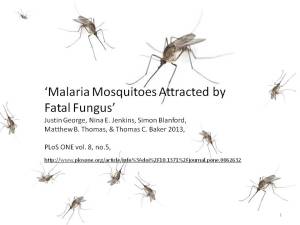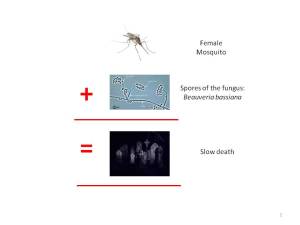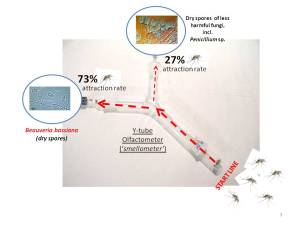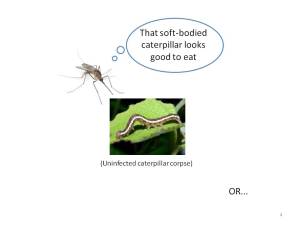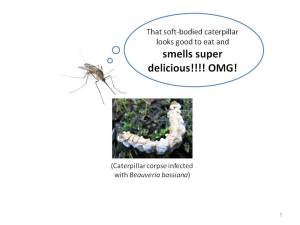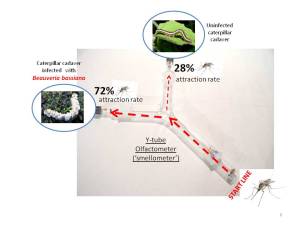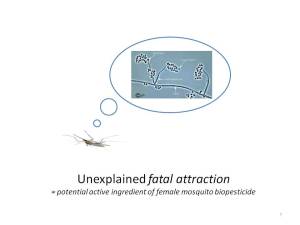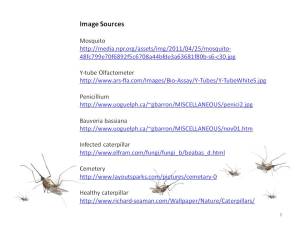A Fatal Attraction to Fungi in 8 Graphics
Posted: July 18, 2013 Filed under: Disease, Research, Uncategorized | Tags: active ingredient, Beauveria bassiana, bio-pesticides, biopesticide, death, fatal attraction, fungi, fungus, hygiene, infectious disease, insecticide, Malaria, malarial research, mosquitoes, pesticide, preventative measures, Research, resistance, vaccination, y-tube olfactometer Leave a commentAs a Thursday night post I’ve decided to share my mini class presentation with you. How lucky are you?! (But ‘lady luck’ could be a whole other blog post topic…)’
As part of the assessment for our ‘Communicating with Science’ course we were required to mentally digest and communicate the contents of a peer-reviewed scientific journal article in a 2 minute timeslot followed by a brief Q & A with our classmates and a couple of obliging ring-ins. It was a very useful and practical exercise pin-pointing what the most significant and interesting aspects of the paper were with a view to being able to then communicate the information clearly and accurately… and of course, engagingly. With another assignment due the previous night preparation time was limited…
I opted for a 2013 paper I had already read for my blog post, ‘Why might stinky feet be so important in the fight against malaria?’ but had only briefly referenced. This is a tale of fatal attraction and I hoped its quirkiness might appeal to the audience comprised of my classmates (and assessors) as it had to me.
The Paper…
The paper detailed experiments focussing upon fungus as an active ingredient in a biopesticide control of malaria mosquitoes. I love it when the natural world has the answers, and especially when those solutions can trump our own ‘inventions’ and their associated adverse side effects. And so the concept of biopesticides (with a likelihood of less harmful side effects) seems really cool to me.
The Presentation…
Slide 1.
Malaria is a mosquito-borne infectious disease. It begins with a bite from an infected female mosquito, which introduces the microorganisms through saliva into the circulatory system from where they travel to the liver to mature and reproduce.
A mounting problem with preventative measures for controlling malaria is that mosquitoes are becoming resistant to some chemical insecticides and so some researchers are looking at alternative biopesticides (‘a form of pesticide based on micro-organisms or natural products’).
(Click on slide for enlarged image)
Slide 2.
In this case the active ingredient under research is a fungus called Beauveria bassiana which infects insects and kills them slowly (in relative terms for insects… 1-2 weeks for mosquitoes).
(Click on slide for enlarged image)
Slide 3.
Previous research has shown insects may be deterred from landing upon pesticides which are harmful to them. If the fungus proved a deterrant to its target than it would not be an effective active ingredient in a biopesticide. Hence, the researchers wanted to see if mosquitoes would be repelled by the Beauveria bassiana. They did this by giving a ‘cage’ of mosquitoes a choice between two fungi using a y-tube olfactometer (I like to call it a ‘smellometer’). And to the researchers’ collective delight, the mosquitoes chose Beauvaria (despite its fatal effects) over the less harmful and obviously less sweeter smelling Penicillium. This suggested the Beauveria bassiana smells almost irresistible to female mosquitoes. That would seem to suggest the researchers had been successful in reaching the objective of their experiments… but they wanted to go further. They knew mosquitoes would almost definitely become infected by landing upon a surface to which dry fungi spores had been applied (tests showed a 95% likelihood) but this would likely prove a very onerous, time intensive and expensive task – especially when considering the extent of land where malaria is present. And so the researchers also looked to prove that Beauveria bassiana is irresistible to female mosquitoes through ‘natural’ transfer.
(Click on slide for enlarged image)
Slide 4.
In this case, the fungus takes advantage of the mosquitoes somewhat gruesome predilection for feeding upon insect larvae, dead or alive. And mosquitoes are particularly partial to the squishy, tender bodies of caterpillars…
(Click on slide for enlarged image)
Slide 5.
… which may already be infected by Beauveria bassiana and dying a slow death. The researchers tested a hypothesis that female mosquitoes would be drawn to infected caterpillars over infection free caterpillars. (Click on slide for enlarged image)
Slide 6.
The earlier test was repeated but with cadavers of caterpillars infected with Beauvaria bassiana against caterpillar cadavers which weren’t infected. Similar results were achieved.
(Click on slide for enlarged image)
Slide 7.
While this proves that Beauveria bassiana could be a very useful active ingredient in bio-pesticides to prevent malaria, the researchers couldn’t fully explain the fatal attraction the fungus had for the female mosquitoes. These are also experiments at the early stage of developing a biopesticide. Conclusion: More research needs to be undertaken.
(Click on slide for enlarged image)
Slide 8.
Interestingly, research has also shown, the slow death by biopesticides (in comparison to the rapid death caused by insecticides) also makes it harder for the mosquito population to build up a resistance. Isn’t that cool considering the ability of mosquitoes to build up resistance to traditional pesticides has been affecting the ability to control mosquito populations recently? Win-win, I say.
(Click on slide for enlarged image)
In case, you’re wondering – Yes it did run over the allocated two minutes…. do you know how fast two minute speeds by? Feedback suggested I could have left out slides 4, 5 & 6 and just covered the key investigation of the experiment.
Interesting questions I fielded from the audience included among others: whether application costs of biopesticides were affordable and would this affect its viability ergo was cost a factor between traditional pesticides and biopesticides; and could mosquitoes infect eachother… do they feed on eachother as they do on other insects? Do any readers know the answers?

